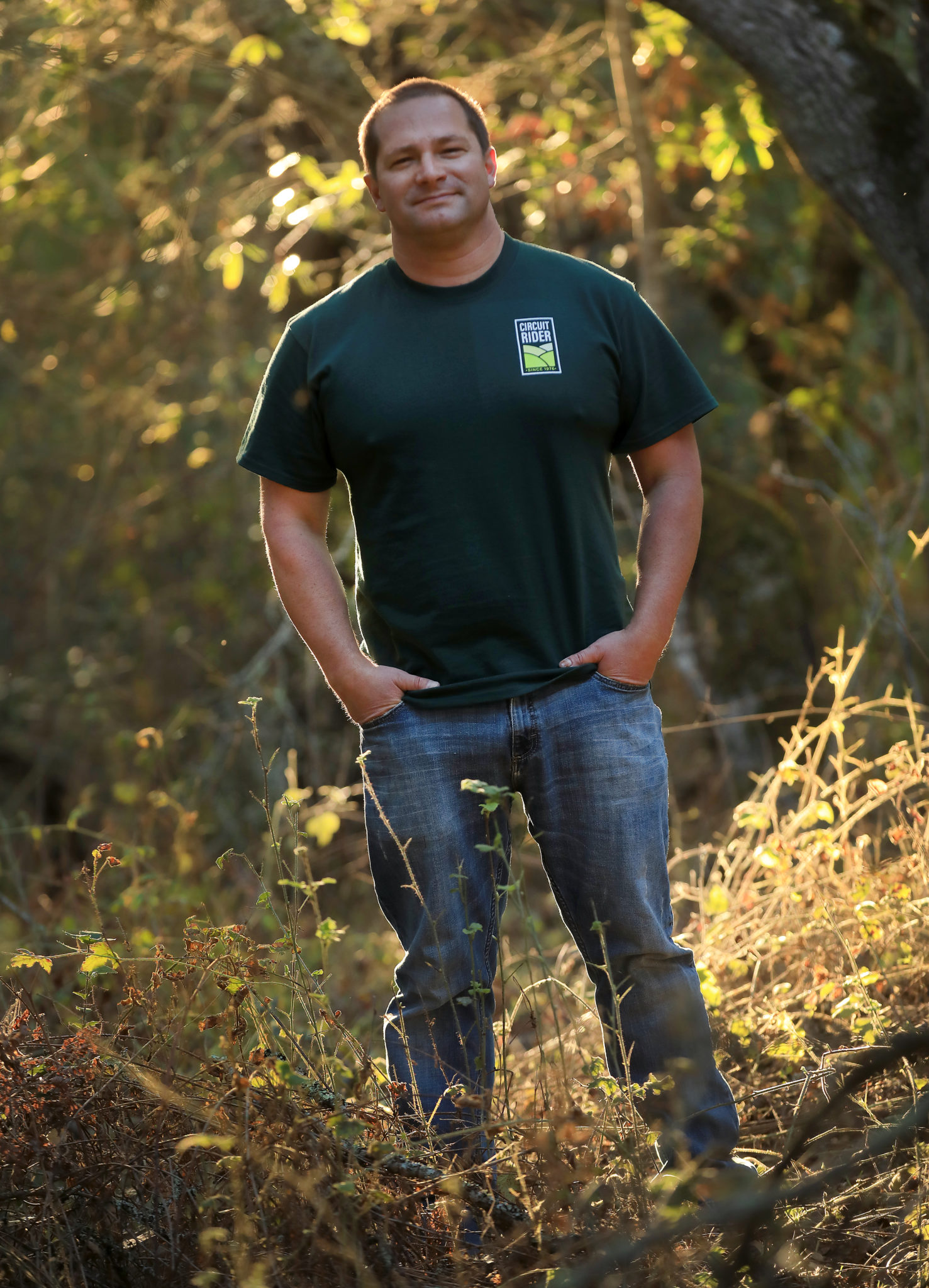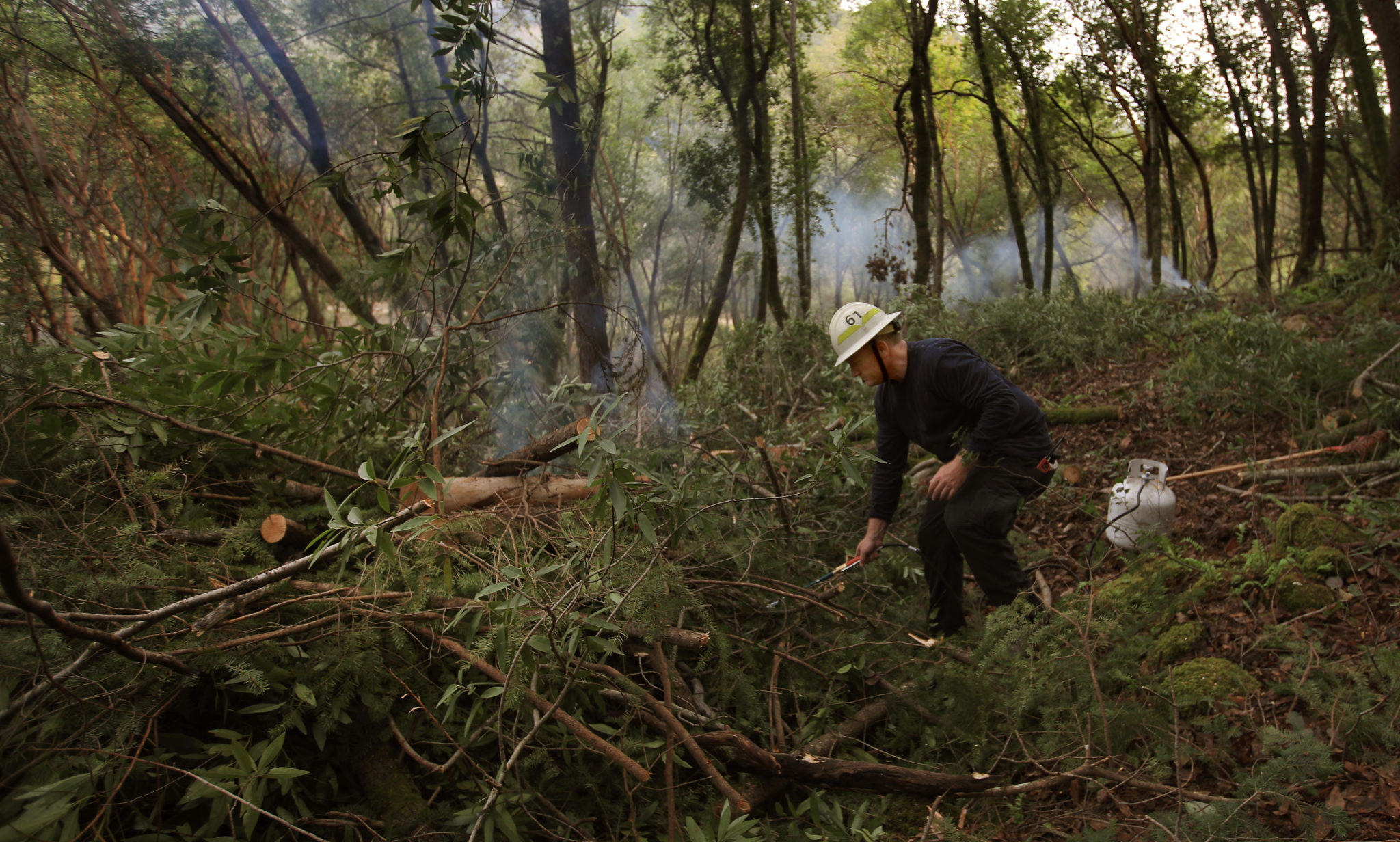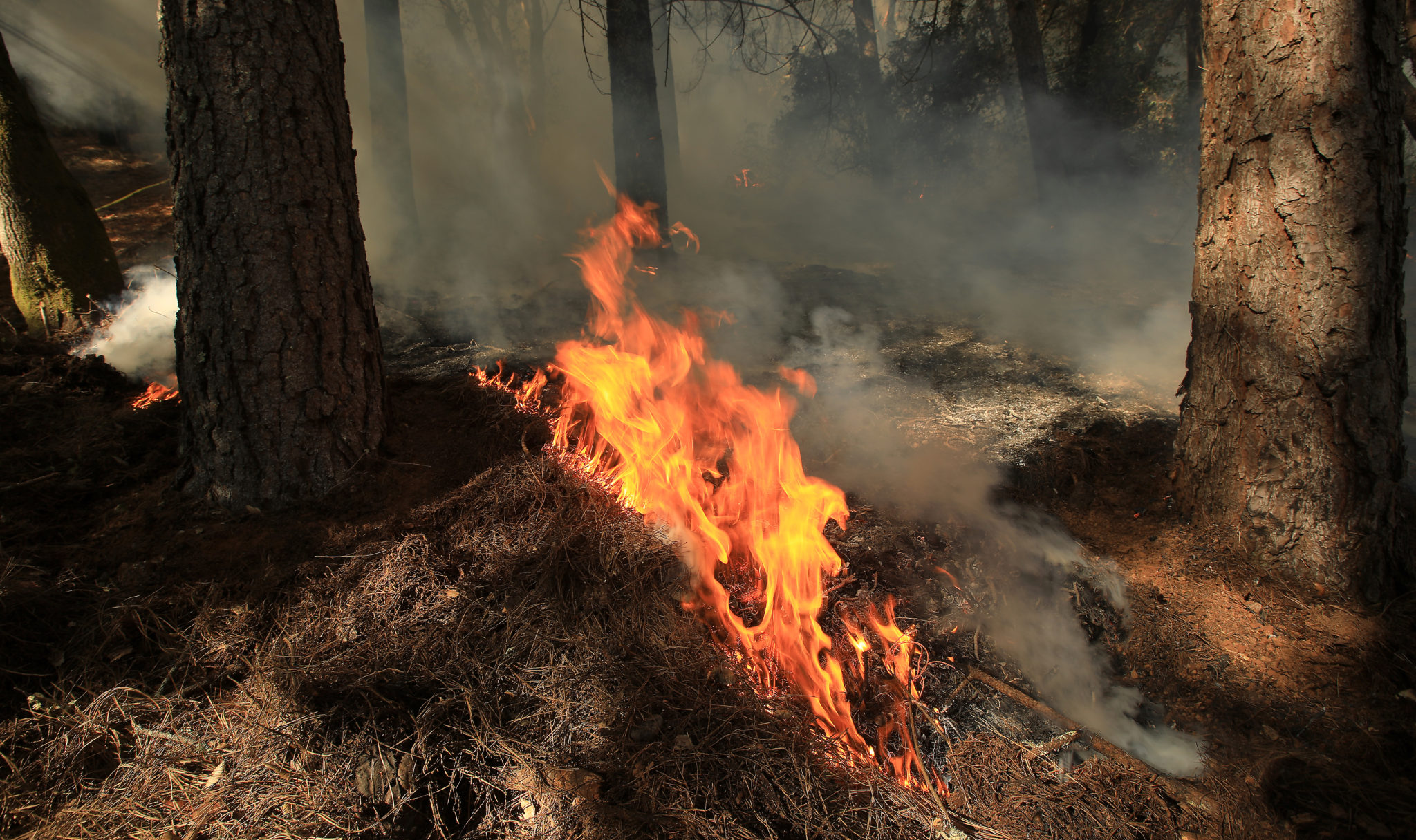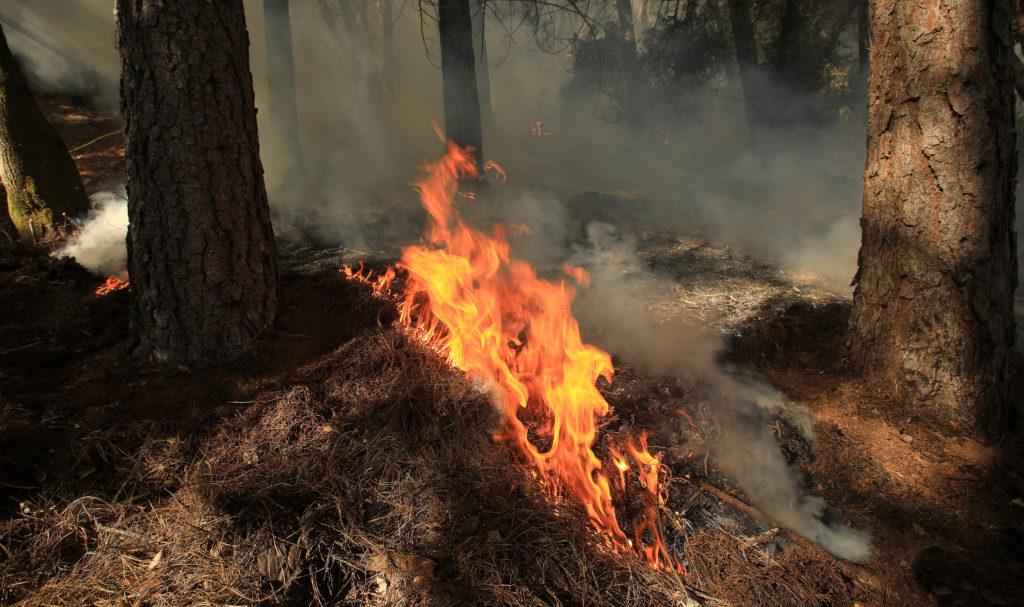After a more than a century of no-fire-shall-pass land management, the movement to reintroduce small-scale controlled burns has taken a promising hold in Sonoma County. More landowners than ever are teaming up with ‘burn bosses,’ scientists, and a growing corps of enthusiastic volunteers to restore ‘good fire’ to the landscape — and make us safer and more resilient for the wildfires to come.
Che Casul, a seventh-generation Sonoma County rancher, badly wanted to see his woods on fire. With three others, he walked along the edge of a 33-acre patch of oak woodlands on his family’s Bodega Highway ranch. They carried drip torches filled with diesel fuel and gasoline. As they paced their way through the forest, they released small flaming droplets meant to coalesce into a wider curtain of flames creeping along the earthen floor — a prescribed fire.
But it was a damp December day, with light rain falling by afternoon across this corner of southwestern Sonoma County, so the flames that did spread were subdued, producing a blue smoke that hovered just above the ground, swirling around the two dozen men and women clad in yellow firefighter gear and spread throughout the woodland.
Casul, 34, had invited the firefighters onto the property, part of a controlled deployment of fire that had been in the works many months earlier — as catastrophic wildfires once again overtook California, burning a record 4.2 million acres, including more than 290,000 acres of Sonoma and Napa counties.
For Casul and the team of firefighters and volunteers assembled on his 213-acre spread just inland from the Sonoma Coast, conditions were less combustible, partly by design.

Casul employs a variety of tools to reduce wildfire risk on his ranch. Prescribed burning is just one of them. The weather has its say, too.
“Honestly, for me it didn’t burn as hot as I wanted it to,” he later said.
Yet, after a full survey of the treated acreage, Casul professed to being amazed by the skillful approach with which the crews had targeted the most obvious hazard fuels: dead trees, towering stick dens for wood rats, and the limbs hanging down from oak and bay trees — dangerous for their ability to draw flames up into the canopy and cast embers that spark more wildfire.
“Even in the most challenging conditions to do a burn, they were able to burn epic amounts of these big trees and big rats’ nests and big jackpots,” says Casul, who carries his cheery demeanor above a set of broad shoulders on a stocky frame — one rooted in a family that has raised cattle and other livestock in this part of the county since 1851. Across Bodega Highway from the family ranch stands the historic one-room Watson School, built by Casul’s great-great-great-great-grandfather.
In a sense, the prescribed fire lit on the ranch that winter day—one of four controlled burns happening simultaneously across the county on Dec. 11 — is part of another tradition that landowners, fire officials, local tribes and ecologists are reviving to blunt the rising risk of rampant wildfires in a warming climate and provide other landscape and cultural benefits.
Cal Fire Division Chief Ben Nicholls, who oversees Sonoma County, says it’s a must-have campaign — a way to create defensive buffers around and between developed areas and establish strategic fire breaks in increasingly fire-prone regions like the Mark West Creek corridor north of Santa Rosa.
That’s where the wind-whipped Tubbs fire raced out of the canyon in October 2017 and into flatland neighborhoods, leveling thousands of homes on both sides of Highway 101. Some of the same ridges dividing Napa and
Sonoma counties proved vulnerable again last summer, when in a matter of hours, the Glass fire sped west over the hills and into Santa Rosa, wreaking more destruction.
“When millions of acres burn and the skies turn orange for days on end, clearly we need to do something different,” Nicholls says.
A growing movement
Harnessing wildfire for human use is nothing new. Across California and much of the western United States, native people have used flames to clear out cluttered forests, promote plant growth and flush game.
But after more than a century of fire suppression on public and private lands, with sometimes disastrous consequences, the push for greater use of “good fire” has grown stronger in recent decades, especially in the face of a new, more explosive era of mega fires.
Civilian volunteers are enlisting in large numbers for prescribed fire training, seeking a proactive alternative to waiting in dread for the next major blowup.
And Cal Fire, the state’s forestry and firefighting agency, has committed to putting more controlled fire on the landscape, and making it easier for landowners and community organizations to do so, as well.
The movement may not stop the next Tubbs fire — or the sequels of last summer, the Glass and LNU Complex fires that rampaged across Wine Country. But it might at least reduce the intensity of the flames hurtling helter skelter toward communities in their path.
The movement also offers a choice, given changing conditions in the western United States that experts say mean fuel-loaded areas are going to burn eventually, one way or another.

“Do we want to burn it on our terms, where we can?” says Cal Fire Battalion Chief Marshall Turbeville, who also heads the Northern Sonoma County Fire Protection District. “Or do we want it to burn during a wildfire?”
It’s taken generations to reach this point, with stiff political and institutional resistance at nearly every step. And the campaign still faces a wide set of obstacles, among them the calculated risks taken when employing a force this powerful across a wide swath of the nation’s most populated state.
Cost is another. Gov. Gavin Newsom’s 2021-22 budget proposal includes an additional $1 billion toward wildfire resilience and forest health programs. Among them are efforts to widen the network of fire and fuel breaks, where vegetation is strategically thinned or eliminated to help slow a wildfire’s advance.
To treat that acreage, manual and mechanical work can run up to $4,000 per acre, meaning it would cost up to $2 billion — twice Newsom’s entire fire prevention budget for the state — to address all of the more than 500,000 acres of coniferous forest and oak woodlands covering Sonoma County.
“The scale of what we need to do is not going to happen overnight. It’s going to take years, even generations. This is the biggest issue facing our generation.”
~ Cal Fire Battalion Chief Marshall Turbeville
Prescribed burning is cheaper, and though nothing on the order of a countywide plan is in the works, Sonoma is emerging as a hot spot for the revival of the smaller-scale prescribed burns that together aim to reduce a century of accumulated fuels. Fire agencies gearing up to put more flames on the land and new cooperative efforts are gaining steam, drawing volunteers eager to help.
“We’re lucky in Sonoma County that we have a lot of talented, creative people that are interested in this,” said ranch manager David Katz, who is working to plan some burning for the 1,600-acre ranch he runs near Stewarts Point on the Sonoma coast.
Katz, a former executive director of the Sonoma Land Trust, says he’s particularly taken with the ability of grassroots organizations and local leaders to engage “a wide cross section of people — everybody from Cal Fire to the livestock industry, to forest owners, to ecological and conservation activists, on down. And there’s a bunch of forums and lots of positive intervention among these parties who, in the past, were at loggerheads in dealing with some of this stuff.”
Not a ‘one and done’ solution
For landowners, hosting a beneficial burn is not nearly so easy as calling up firefighters and lighting a match. While private landowners have wide latitude to conduct beneficial burns on their own property between the declared end of wildfire season and May 1 of a given year, they still must obtain an air quality permit and bear responsibility on rare occasions when a problem might occur.
Burns conducted by Cal Fire, with a Cal Fire permit, or by public agencies, also require time-consuming biological and archaeological reviews of the area before they are authorized.
There are bird nesting seasons, weather variations and shortened winter days to consider when planning burns, as well.
Some areas, particularly where wooded or forested landscapes are concerned, may require substantial pre-fire thinning and pruning work before any flames are ignited.
It’s also not a “one and done” solution, either. Plants regrow.
“It’s an easy idea—not an easy fix,” said Tony Nelson, the Sonoma Valley program manager for the Sonoma Land Trust.
Prescribed burning has a long history in Sonoma County, where tribes have long used flames to manage and maintain diverse landscapes for food production and other beneficial uses — until European settlers quashed those traditions.
Father Jose Altimira, who founded the California mission in Sonoma in 1823, wrote in his diary of seeing burned and blackened hillsides on his passage through the North Bay and Sonoma Valley.
The practice continued in places with ranchers, who used flames to clear brush and improve rangeland.
Bob Cooley, whose 19,000-acre family ranch straddles the Sonoma-Mendocino county line, hosted some of the earliest, large-scale Cal Fire burns in the region a few decades back. He figures he was probably 5 years old when his dad, Crawford, had him running up and down the canyons all day long with a drip cannon, lighting small burns.
“It was one of our summer activities,” just as it had been for his father, Bob Cooley said. The family and a few friends would burn as much as 4,000 acres before they were done.
But prescribed fire still remained largely unfamiliar to the masses for most of the 20th century, even anathema to generations raised under the tutelage of Smokey Bear and policies that called for putting out flames as quickly as possible wherever they appeared.
Even amid mounting evidence of fire’s sometimes beneficial role, it took decades for government agencies and fire professionals – what the Nature Conservancy’s fire training coordinator Jeremy Bailey calls the “fire industrial complex” — to get on board, and then only in a limited way.
When prescribed fire did occur in California, for many years it tended to be federal agencies doing specific projects focused primarily on ecological benefits in a very narrow, siloed fashion, says Lenya Quinn-Davidson, Eureka area fire advisor for the UC Cooperative Extension.
As a result, mass accumulations of ready forest fuel have become both a practical and political problem in the age of extreme fire behavior and increasingly frequent and destructive firestorms across the west. Recall former President Donald Trump slamming California for poor forest management as wildfire raged last year across the state. A counter chorus was quick to note that nearly half of the state, and much of the land then ablaze, is under federal ownership.
A new alliance, a shift in attitudes
As Quinn-Davidson recalls, however, it took inspiration in the form of regular people in “blue jeans and cowboy hats” conducting huge burns in Nebraska to kickstart the first of a growing network of grassroots organizations that are now driving the return of fire to a wider span of the state, Sonoma County among them.
She co-founded that pioneering group, Humboldt County Prescribed Burn Association, three years ago, paving the way for a dozen others. They include the Sonoma-based Good Fire Alliance, one of several robust collaborations built around the North Bay’s surplus of homegrown and university-trained experts, ecological stewards, nonprofit land managers, and fire service partners.
The loosely organized Good Fire Alliance provides opportunities for landowners to learn how to manage vegetation and to get help conducting prescribed burns — from both volunteer crews and one another, says Jared Childress, a Sonoma County prescribed burns specialist who was instrumental in its creation.
Landowners who want to host a broadcast burn in their pasture or on a brush-covered hillside, or even incinerate piles of old wood and branches collected from a wooded area or shaded fuel break, can put out the word to folks willing to come help out on a given day.
The alliance allows volunteers to gain field experience, many of them through the Fire Forward program operated by Audubon Canyon Ranch, a 60-year-old environmental conservation and education nonprofit that owns land preserves in Sonoma and Marin counties. ACR also is a founding member of the Bay Area Prescribed Fire Council, an umbrella group for organizations collaborating on controlled burns.
“If we’re actually going to see a real mindset change, we need to be doing this where people are, and have it be front and center where people are aware and learning about it and experiencing it.”
~ Fire ecologist Sasha Berleman

One of the hardest-charging leaders in the local movement is Sasha Berleman, a 31-year-old wildland firefighter with a doctorate in wildfire science from UC Berkeley. She leads ACR’s Fire Forward, which is spreading the gospel and capacity for prescribed burns among landowners and everyday recruits alike.
In a short span of time, Berleman’s program has helped Sonoma County become a leader in community-based fire — a not altogether predictable role, given the area’s large suburban population and mixed pattern of land ownership. Many others in her field flock to wilder locales in the west.
“For many years there was a very strong statement being made that you cannot do prescribed burning in places that have people, and you can only do prescribed burning way out in the wilderness where no one can smell it or see it,” Berleman says. “That doesn’t seem like a real solution. If we’re actually going to see a real mindset change, we need to be doing this where people are and have it be front and center where people are aware and learning about it and experiencing it.”
Berleman has taken the lead on proactive burns around the region and, in a big step, last year worked with Turbeville and fellow Cal Fire officials to arrange for more than three dozen trained volunteers to rotate through mop-up duty on the 55,209-acre Walbridge fire in west Sonoma County while attached to the Northern Sonoma County Fire Protection District’s rare fuels reduction crew, a model many hope can be replicated elsewhere.
Berleman says the shift in societal attitudes toward prescribed fire has been “really drastic” over the past several years, but “exponential” in the past 12 months.
“Just in 2015, if I told someone I was a fire ecologist, they thought I was an arsonist or a pyromaniac,” she says. “But now when I tell someone what I do, they can’t help but lecture me on the value of prescribed burning in California.”
200,000 of 1 million acres burned
Berleman’s colleague, Brian Peterson, a fire ecologist with Fire Forward, says he likes to bring observers to prescribed fires so they can see how organized and safe it is when conducted properly. He calls it the “aha moment.”
“Quite often, a prescribed burn is boring,” he says.
Participants using fuel torches paint flames in a band or “black line” around the edges of the area to be burned, or use fire roads or other wide areas as borders, walking in staggered lines as they drag flames into the wind to slow the spread. Sometimes they paint circles of flames on the ground around a tree to keep encroaching fire away and, on a slope, burn downhill so the flames burn at low intensity.
Berleman likens fire on a hillside to a flaming match, burning slowly down when held upright, but exploding in a fiery flash when inverted.
“We manage a fire for short flame lengths by starting at the top and moving down,” she said. “We’re not letting that fire build energy. We’re forcing that fire to move the direction we want it to burn.”
The program she and Peterson lead provides blended online and in-person training that offers participants federal certification in basic wildland firefighting, qualifying them to participate in prescribed burns.
To date, 180 people have completed the program through Fire Forward, with 90 more scheduled to finish in March, and another 85 on a waiting list, as more and more people learn of the training and sign up. Since last fall, all of the two-day training sessions have sold out.
The program draws people who work in land management, conservation, environmental stewardship and fire science – as well as people with desk jobs seeking a way to make a difference and assume shared responsibility for the future.
“If we want California to be a habitable place for human beings, we need to engage with the environment around us in a more active way,” says one alum, Santa Rosa resident Peter Nelson, a professor of ethnic studies and environmental science at UC Berkeley. Nelson is also a tribal member of the Federated Indians of Graton Rancheria, and notes that California tribes have worked to varying degrees to hang onto their traditional use of fire.
The Central Coast Amah Mutsun formed a nonprofit land trust and job corps focused on indigenous land management and cultural burning. The Kashia Band of Pomo Indians in Sonoma County is similarly working to reintroduce fire on its tribal lands, including a nearly 700-acre coastal property acquired with the help of conservation groups in 2015.
Nina Hapner, the tribe’s director of environmental planning, says there remain among Kashia elders memories of cultural burning but that there is still some fear associated with fire among newer generations, though that is changing in the wake of recent disasters.
She notes that the Meyers fire near Fort Ross slowed last year when it encountered an area that had been burned proactively.
“When you haven’t really been able to utilize [fire] as a tool, people dismiss it. You kind of just file it away,” Hapner says. “But now the opportunity is there.”
More burning also is coming through the Sonoma Valley Wildlands Collaborative, a group of six conservation and land management organizations that oversee 18,000 acres of open space.
The organization includes Audubon Canyon Ranch, California State Parks, Sonoma County Agricultural Preservation and Open Space District, Sonoma County Regional Parks, the Sonoma Land Trust, and the Sonoma Mountain Ranch Preservation Foundation, which combined manage 11 sites in the region. The group came together after many of those properties were charred by the Nuns fire, one of the series of historic and deadly 2017 wildfires, including the Tubbs, that erupted around the North Bay amid hurricane force winds, killing 24 people and destroying 5,300 homes in Sonoma County.
The firestorm served as a tragic pivot point in the public and policymakers’ understanding of the nature of wildfire in the modern west. The years since have only driven that point home.
Wildfires have now charred about 200,000 acres of Sonoma County’s roughly 1 million acres just since 2017, Cal Fire’s Nicholls said. In Napa and Lake counties, the share of recently burned ground is even higher.
“We’ve had at least three years now where we’ve had wildfires that have touched everybody that lives in Sonoma County,” Turbeville said. “I would assume almost everybody knows somebody who lost a house or was affected.”
Creating defensive barriers
The most coordinated effort to reintroduce fire in Sonoma County is taking place in Sonoma Valley, where the Glass fire besieged rural neighborhoods in late September 2020, burning more than 330 homes, including 34 inside Santa Rosa city limits.
Already, a $1 million Cal Fire grant is helping to fund fire breaks and fuel reduction work on sites governed by the wildland collaborative, much of it quite costly hand work, says Nelson, with the Sonoma Land Trust.
The collaborative is working with Cal Fire on a 10-year vegetation management plan that will include about 200 acres of prescribed burning a year across the agency sites involved. Outside of that arrangement, Audubon Canyon Ranch’s Bouverie Preserve off Highway 12 has hosted prescribed fires in different areas three times since 2017, spanning more than 60 acres. Across the highway, Sonoma Valley Regional Park has hosted at least two burns, spanning 50 acres.
Nicholls says the idea is to create a crescent-shaped buffer from about Hood Mountain to Sonoma Mountain that would help stall a wildfire trying to cross Highway 12, shielding a critical travel route, while also giving firefighting crews a place to operate from, should wildfire arrive.
Further north, up to 400 acres of the 3,200-acre Pepperwood Preserve northeast of Santa Rosa is slated for controlled burns over the next year or two, as is 265 acres of the 5,600-acre Jenner Headlands Preserve on the Sonoma Coast.
In an ideal world, Nicholls and Turbeville say they wish they could substantially scale up burning, ringing communities on the edge of wildlands with fire-treated landscape and creating broad barriers across windy ridgetops north of Santa Rosa, Sonoma Valley, and Cazadero, for instance, or tying together large, undeveloped properties that could slow or curb flames before they reach homes.
“I don’t know if Santa Rosa agrees with me,” Turbeville says, “but, like areas near Fountaingrove or Montecito or Wikiup, managing the wildlands that abut residences in the urban development, to basically create a buffer.”
The two officials highlight strategic ridgetops around the county, including Mt. Barham at the top of the Calistoga Grade, above St. Helena Road, which could be part of a defensive barrier if another fire were to come across Mark West Canyon.
Turbeville also talks of extending existing fire roads, ridgetop burns and bulldozer lines in wildfire scars, to take advantage of what’s already available.
Nicholls cited regional parks and other protected spaces as natural starting points, saying a burn is slated for Shiloh Ranch Regional Park east of Windsor as the beginning of an effort to “connect the dots between large landholdings” from there to Pepperwood to Calistoga Road.
“The scale of what we need to do is not going to happen overnight. It’s going to take years, even generations,” said Turbeville. “This is the biggest issue facing our generation.”
And that issue is not reserved for firefighters or volunteers alone.
Tom Knecht, the “prefire” division chief for Cal Fire’s six-county Sonoma-Lake-Napa Unit, says even with his agency’s pledge to increase the scale and pace of its landscape work, there’s a role for everyone – whether it’s ensuring defensible space around their own homes and working out ways to harden their home construction, or collaborating with a prescribed fire association to reduce fuel around their community.
“What I see in my career is no one wants to do anything until a fire runs through their neighborhood, and then all of a sudden, people say, ‘Oh my God, Cal Fire, what are you going to do for me next time?’ “Cal Fire can’t do it all, even with all of our stakeholders. We can’t do it all,” Knecht says.
A sense of purpose and hope
Since taking over the family ranch in west county after college, Che Casul has looked for every opportunity to mitigate fire risks. He grazes shaggy Angus and Scottish Highland cattle because one breed keeps down the grass, the other, the brush.
He also has 100 head of free-range goats whose appetite for anything under five feet high may be one reason it was so difficult to get a fire going in the oak woodlands last winter. Still, those woods remain too densely packed with bay trees and Douglas firs to walk through freely, the way he did as a child.
From that same era, he remembers wandering along beside his grandfather, who used a match and a shovel to set fire to his pastures, regenerating them for the following year.
It took until this past year for Casul to host his first prescribed fire.
Several initial attempts were called off because it was too hot or dry or windy. When December 11 came, it was a bit too wet, but the results were still gratifying.
“If we want California to be a habitable place for human beings, we need to engage with the environment around us in a more active way.”
~ Environmental science professor Peter Nelson
So Casul is now one of Berleman’s adherents, planning with his wife, Angela, to take the basic wildfire training through Fire Forward this year.
As chief executive of newly renamed nonprofit Circuit Riders — formerly the Center for Social and Environmental Stewardship — he’s also been keen to promote fuels management through the organization’s vocational training and work programs.
Casul says there are no fire fuels contractors in the county right now, and he imagines young people developing expertise and finding rewarding careers that satisfy an urgent community need.
“A lot of these pieces can fit hand in glove,” he says. “It creates a healthier ecology and it makes our community safer, and it puts money in the pockets of at-risk youth who are learning new skills.”
Turbeville makes a similar point, noting that it may take generations to catch up after allowing so many years of fuel to accumulate.
In northern Sonoma County, he oversaw five burns spanning about 170 acres last fall, until his crew just ran out of days. They were at it again come January.
“I still tell people that my dream job is to go to work and stop a fire. Or go to work and start a fire,” he said.
Berleman says that her line of work runs the risk of bearing a message to people who do not want to hear it.
But in Sonoma County, she’s found a ready audience, one in which a growing number of people understand that a landscape under threat requires the stewardship of those who evolved with it.
“There are so many problems in the world that feel unsolvable, and this one feels like there’s such a great solution right there if we just seize it,” Berleman says. “In a world full of problems, it gives me a sense of purpose and a hope for a better future in this one sliver, and I think we’re seeing a lot of the community feel the same way.”

Barriers to Broader Burning
How to scale up to put more prescribed fire on the ground?
That’s the dilemma facing experts and volunteers, as the state pushes to employ more controlled burns to combat increasingly extreme fire danger.
Such burns are an efficient, inexpensive option in many cases, compared to labor-intensive manual thinning and mechanical treatments, which can cost $2,500 to $4,000 an acre and up, depending if equipment like a wood chipper or pile burning is needed.
An equivalent per-acre cost for prescribed fire is hard to come by as weather, topography, fuel type, and a variety of other factors enter in. Manual work may be required in advance of some while other fires may be accomplished with a $250 air district permit and lunch for a crew of hearty volunteers.
But where larger obstacles exist — say liability or insurance, or even available workforce — Cal Fire, California’s chief firefighting agency, has pledged to work to reduce barriers.
That includes streamlined permitting for public agencies or other qualifying entities, increased training opportunities, and new certification standards for “burn bosses” — the individuals who take command of prescribed fires.
Lenya Quinn-Davidson of the UC Cooperative Extension and Jeremy Bailey, director of fire training for the Nature Conservancy’s North American Fire Team, say a critical hurdle would be eliminated if California adopted a gross negligence standard for prescribed burning liability, like some other states have.
There’s also need for providers to develop insurance options for certified burn bosses — a kind of insurance for which, so far, there’s just not been much demand, says Quinn-Davidson.
“We need all hands on deck,” says Quinn-Davidson. “If we’re really going to scale up this work, we need to be lifting up and funding and supporting anyone who wants to be involved in this work. We need to really be thinking about, ‘How can we get the most people trained and involved and feeling supported?’”


























